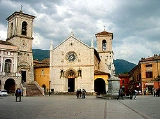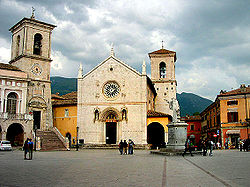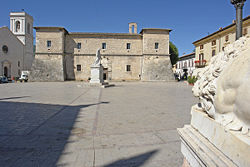
Norcia
Encyclopedia


Comune
In Italy, the comune is the basic administrative division, and may be properly approximated in casual speech by the English word township or municipality.-Importance and function:...
in the province of Perugia
Province of Perugia
The Province of Perugia is the larger of the two provinces in the Umbria region of Italy, comprising two-thirds of both the area and population of the region. Its capital is the city of Perugia...
(Italy
Italy
Italy , officially the Italian Republic languages]] under the European Charter for Regional or Minority Languages. In each of these, Italy's official name is as follows:;;;;;;;;), is a unitary parliamentary republic in South-Central Europe. To the north it borders France, Switzerland, Austria and...
) in southeastern Umbria
Umbria
Umbria is a region of modern central Italy. It is one of the smallest Italian regions and the only peninsular region that is landlocked.Its capital is Perugia.Assisi and Norcia are historical towns associated with St. Francis of Assisi, and St...
, located in a wide plain abutting the Monti Sibillini, a subrange of the Apennines with some of its highest peaks, near the Sordo River
Sordo River
The Sordo is a small river in eastern Umbria in Italy. Its source is about 1 km south of Norcia at an approximate altitude of 600 m , and it flows for about west to Serravalle where it empties into the Corno....
, a small stream that eventually flows into the Nera. The town is thus popularly associated with the Valnerina (the valley of that river).
The area is known for its air and scenery, and is a base for mountaineering and hiking. It is also widely known for hunting, especially of the wild boar, and for sausages and ham made from wild boar and pork, to the point that Norcia has given its name to such products: in Italian, norcineria.
History
Traces of human settlement in Norcia's area dates back to the NeolithicNeolithic
The Neolithic Age, Era, or Period, or New Stone Age, was a period in the development of human technology, beginning about 9500 BC in some parts of the Middle East, and later in other parts of the world. It is traditionally considered as the last part of the Stone Age...
Age.
The town's history begins with settlement by the Sabines in the 5th century BC. It became an ally of ancient Rome in 205 BC, during the Second Punic War
Punic Wars
The Punic Wars were a series of three wars fought between Rome and Carthage from 264 B.C.E. to 146 B.C.E. At the time, they were probably the largest wars that had ever taken place...
, when it was known in Latin as Nursia, but the earliest extant Roman ruins date from around the 1st century.
St. Benedict
Benedict of Nursia
Saint Benedict of Nursia is a Christian saint, honored by the Roman Catholic Church as the patron saint of Europe and students.Benedict founded twelve communities for monks at Subiaco, about to the east of Rome, before moving to Monte Cassino in the mountains of southern Italy. There is no...
, the founder of the Benedictine
Benedictine
Benedictine refers to the spirituality and consecrated life in accordance with the Rule of St Benedict, written by Benedict of Nursia in the sixth century for the cenobitic communities he founded in central Italy. The most notable of these is Monte Cassino, the first monastery founded by Benedict...
monastic system, and his twin sister St. Scholastica
Scholastica
Scholastica is a saint of the Eastern Orthodox Churches and the Roman Catholic Church. Born in Italy, she was the twin sister of St. Benedict of Nursia....
, were born here in 480. In the following century the city was conquered by the Lombards
Lombards
The Lombards , also referred to as Longobards, were a Germanic tribe of Scandinavian origin, who from 568 to 774 ruled a Kingdom in Italy...
, becoming part of the Duchy of Spoleto
Duchy of Spoleto
The independent Duchy of Spoleto was a Lombard territory founded about 570 in central Italy by the Lombard dux Faroald.- Lombards :The Lombards, a Germanic people, had invaded Italy in 568 and conquered much of it, establishing a Kingdom divided between several dukes dependent on the King, who had...
. In the 9th century it suffered from Saracen
Saracen
Saracen was a term used by the ancient Romans to refer to a people who lived in desert areas in and around the Roman province of Arabia, and who were distinguished from Arabs. In Europe during the Middle Ages the term was expanded to include Arabs, and then all who professed the religion of Islam...
attacks, which started a period of deep decadence.
In the 11th century, it was part of the domain of St. Henry, Holy Roman Emperor.In the 12th century Norcia became an independent commune within the Papal
Papal States
The Papal State, State of the Church, or Pontifical States were among the major historical states of Italy from roughly the 6th century until the Italian peninsula was unified in 1861 by the Kingdom of Piedmont-Sardinia .The Papal States comprised territories under...
territories, with an increasing political and economical prestige. The collaboration with the Benedictine abbey in Preci
Preci
Preci is a comune in the Province of Perugia in the Italian region Umbria, located about 60 km southeast of Perugia.It is a medieval burg developed inside a fortress, which was almost entirely destroyed by an earthquake in 1328.Preci borders the following municipalities: Castelsantangelo sul...
led to the creation of the Schola Chirurgica: the latter's studies allowed Norcia's to improve their swine breeding capacities. However, the vicinity of the powerful Spoleto
Spoleto
Spoleto is an ancient city in the Italian province of Perugia in east central Umbria on a foothill of the Apennines. It is S. of Trevi, N. of Terni, SE of Perugia; SE of Florence; and N of Rome.-History:...
and the 1324 earthquake thwarted the city's ambitions, and in 1354 it returned definitively under the Papal authority.
Main sights
The older core of Norcia is almost flat, which is relatively unusual among the towns of Umbria, and completely enclosed by a full circuit of walls that has survived intact from the 14th century, despite many earthquakes of which several were devastating (1763, 1859, 1979). After the earthquake of August 22, 1859, the Papal StatesPapal States
The Papal State, State of the Church, or Pontifical States were among the major historical states of Italy from roughly the 6th century until the Italian peninsula was unified in 1861 by the Kingdom of Piedmont-Sardinia .The Papal States comprised territories under...
, to which Norcia then belonged, imposed a stringent construction code forbidding structures of more than 3 stories and requiring the use of certain materials and building techniques.
Many other Roman vestiges are observable throughout the city, especially in the walls of San Lorenzo, its oldest extant church.
The main basilica is dedicated to St. Benedict, still attached to a functioning Benedictine monastery. Though the present edifice was built in the 13th century, it stands on the remains of one or more small Roman buildings, sometimes considered to have been a Roman basilica, or alternately the actual house in which the twin saints were born. The façade, in Gothic style, is characterized by a central rose window and relief portraying the four Evangelists. Inside, the fresco of the Resurrection of Lazarus, (1560) was painted by Michelangelo Carducci
Michelangelo Carducci
Michelangelo Carducci was a 16th century Italian painter of the Renaissance period active in Umbria. He was born in Norcia. Extant works include:*Resurrection of Lazarus, fresco in the Basilica of San Benedetto, Norcia...
. The altar in the left hand transept houses a St Benedict and Totila (1621) by Filippo Napoletano
Filippo Napoletano
Filippo Napoletano was an Italian artist, with a peculiar output, mainly landscape and genre scenes and also drawings or etchings of diverse, often particular, items such as exotic soldiers, skeletons of animals, or cityscapes.He began his career in his native city, Naples and moved to Rome in...
.
The Renaissance church of Santa Maria Argentea is the Duomo
Duomo
Duomo is a term for a cathedral church. The formal word for a church that is presently a cathedral is cattedrale; a Duomo may be either a present or a former cathedral . Some, like the Duomo of Monza, have never been cathedrals, although old and important...
, or cathedral, and houses some works by Flemish masters, a richly decorated altar by Duquesnoy
François Duquesnoy
François Duquesnoy was a Baroque sculptor in Rome. His more idealized representations are often contrasted with the emotional character of Bernini's works, while his style shows greater affinity to Algardi's sculptures....
, a Madonna and Saints by Pomarancio
Niccolò Circignani
Niccolò Circignani was an Italian painter of the late-Renaissance or Mannerist period.Born in Pomarance, he is one of three Italian painters called Pomarancio. His first works are documented from the 1560s, where he painted frescos on the Old Testament stories for the Vatican Belvedere, where he...
, and a St. Vicenzo Ferrer and the Infirm (1756) by Giuseppe Paladini.
The Gothic church of Sant'Agostino (14th century) has many votive frescoes of St Roch and St Sebastian. San Francesco is from the same century: it has a notable portal, surmounted by a Gothic rose window, with pink and white stone decorations.
A fortress, the Castellina, was built in 1555-1563 as the residence of the Papal governors, under design by Giacomo Barozzi da Vignola
Giacomo Barozzi da Vignola
Giacomo Barozzi da Vignola was one of the great Italian architects of 16th century Mannerism. His two great masterpieces are the Villa Farnese at Caprarola and the Jesuits' Church of the Gesù in Rome...
. It now houses a small museum with Roman and medieval artifacts, and documents of the Middle Ages and later periods.
In the frazioni near the town proper, are
- The pieve of San Salvatore, at Campi, with two rose windows and two portals of different ages. Also in Campi is the parish church of St. Andrew, with an original triangular loggiaLoggiaLoggia is the name given to an architectural feature, originally of Minoan design. They are often a gallery or corridor at ground level, sometimes higher, on the facade of a building and open to the air on one side, where it is supported by columns or pierced openings in the wall...
to. - The frazione of Savelli houses the ruins of Madonna della Neve, an elegant octagonal building designed by Bramante and destroyed by the 1979 earthquake.
- In San Pellegrino is the convent of Santa Maria di Montesanto (14th century), now in poor conditions. It has a noteworthy cloister, a church with 17th century canvasses and a 14th century wooden statue portraying the Madonna with Child.
Frazioni
Agriano, Aliena, Ancarano, Biselli, Campi, Casali di Serravalle, Case sparse, Castelluccio, Cortigno, Forca Canapine, Forsivo, Frascaro, Legogne, Monte-Cappelletta, Nottoria, Ocricchio, Ospedaletto, Pescia, Pie' la rocca, Piediripa, Popoli, San Marco, San Pellegrino, Sant'Andrea, Savelli, Serravalle, Valcaldara.Serravalle (also known as Serravalle di Norcia) lies on the Sordo River
Sordo River
The Sordo is a small river in eastern Umbria in Italy. Its source is about 1 km south of Norcia at an approximate altitude of 600 m , and it flows for about west to Serravalle where it empties into the Corno....
a few hundred meters upstream from its confluence with the Corno
Corno River
The Corno is a small river of the northern Lazio and eastern Umbria in Italy. Its source is on the upper slopes of Mount Corno, at an approximate altitude of 1700 m , and it flows for about , almost always due north, past the towns of Leonessa, Ocre, Ruscio, Monteleone di Spoleto, Roccaporena,...
.
External links
- Norcia Town's official site
- Monastery of St. Benedict
- Information about Norcia
- Storia e informazioni su Norcia
- Norcia.Net Town's tourist site
- UmbriaTurismo
- Norcia - Bella Umbria
- Bill Thayer's site

